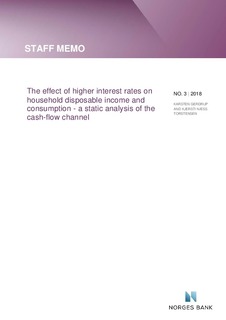| dc.contributor.author | Gerdrup, Karsten R. | |
| dc.contributor.author | Torstensen, Kjersti Næss | |
| dc.date.accessioned | 2018-08-22T13:46:36Z | |
| dc.date.available | 2018-08-22T13:46:36Z | |
| dc.date.issued | 2018 | |
| dc.identifier.isbn | 978-82-8379-037-5 | |
| dc.identifier.issn | 1504-2596 | |
| dc.identifier.uri | http://hdl.handle.net/11250/2558912 | |
| dc.description.abstract | Household debt in Norway has risen substantially over the past 15-20 years relative to both disposable income and bank deposits. An increase in interest rates will therefore reduce disposable income for Norwegian households more than previously. Changes in interest rates can have a direct impact on household consumption via changes in disposable income - an effect generally referred to as the cash-flow channel. In this article, we use tax data from Statistics Norway for all Norwegian households in the period between 2004 and 2015 to shed light on how the cash-flow channel has developed over time. In line with developments in net household debt, we find that the cash-flow effect has become stronger in recent years, but that the increase is somewhat smaller than the total increase in net interest expenses in isolation would imply, owing to increased buffers in the form of liquid assets. | nb_NO |
| dc.language.iso | eng | nb_NO |
| dc.publisher | Norges Bank | nb_NO |
| dc.relation.ispartofseries | Staff Memo;3/2018 | |
| dc.rights | Attribution-NonCommercial-NoDerivatives 4.0 Internasjonal | * |
| dc.rights.uri | http://creativecommons.org/licenses/by-nc-nd/4.0/deed.no | * |
| dc.title | The Effect of Higher Interest Rates on Household Disposable Income and Consumption - a Static Analysis of the Cash-Flow Channel | nb_NO |
| dc.type | Working paper | nb_NO |
| dc.subject.nsi | VDP::Samfunnsvitenskap: 200::Økonomi: 210 | nb_NO |
| dc.source.pagenumber | 19 | nb_NO |

